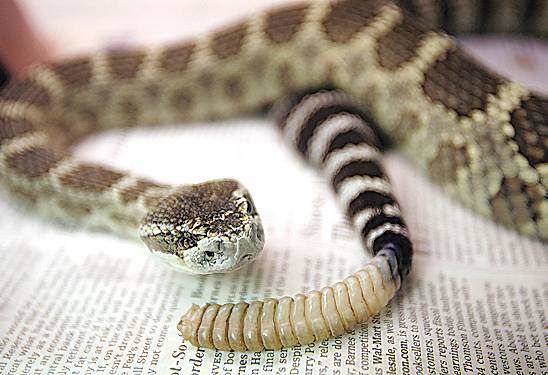A backstage pass to reptiles, raptors and mouse Jell-O
Published 4:00 am Thursday, December 27, 2007

- Medusa, a Northern Pacific rattlesnake, observes visitors Wednesday from her container in a backstage tour at the High Desert Museum.
For the first time, the High Desert Museum is taking its visitors backstage.
People who are willing to pay an extra $25 — in addition to the general admission fee — can go to the museum’s cages and storage rooms to see where the animals live, how they are fed and who cares for them.
While the tour allows people to get close to the animals, museum spokeswoman Cathy Carroll said staff members ensure the visitors stay safe.
All of the creatures are kept in cages and containers and supervised by trained wildlife specialists.
“These are wildlife experts,” Carroll said. “Visitor safety is a top priority.”
The museum decided to start backstage tours with a minimum of two visitors and a maximum of 15 because staff wanted to give people a closer look at its world of reptiles, amphibians, birds, mammals and insects, Carroll said. The museum has never charged for a tour before, and earlier this year it raised its general rates. This roughly one-hour event costs $25 for all non-members except children ages 4 and younger, who get in free.
The museum required a fee for this event, Carroll added, mainly because it wanted to offer an in-depth, exclusive program for people who seek to know more about how the museum works and where many of the animals live.
“The museum is always trying to find new and interesting ways to engage people in the wildlife and the natural and cultural history of the High Desert with the purpose of inspiring people to be good stewards,” Carroll said. “It’s the first time the museum has created a tour like this where people get to see animals that are behind the scenes and talk with the experts directly about what’s involved.”
Eight visitors got a chance Wednesday afternoon to learn from those experts.
As the humans came, Loretta the gopher snake wrapped her body tightly around the arm of Otis Powell, a senior wildlife specialist at the High Desert Museum.
She flicked her tongue at the eight visitors who entered her domain, but did not harm them. Instead, Powell let the people pet Loretta’s scales.
“This is just an incredible program,” said Steve Magidson, 59, of Bend. “It’s to get people behind the scenes to see not only how the museum operates, but how they care for (the animals).”
Magidson and the other visitors started in a small room behind the museum’s indoor “Desertarium” exhibit where Loretta the gopher snake, Gumby the rubber boa and Doc the chuckwalla live.
Powell pulled Doc and Loretta out of their heated abodes and explained how these creatures are mainly used for special school events and as backup, should one of the museum’s main display animals die.
“Be real careful,” Magidson said as people petted Doc. “They can bite.”
Paula Magidson, 71, of California, paid more attention to Loretta the gopher snake.
“I used to bring these home to my mother as a kid,” she said with a laugh.
After playing with Doc and Loretta, the crowd walked into a cold room just outside the Donald M. Kerr Birds of Prey Center. There, George the barn owl, McKenzie the great horned owl and several other raptors nestled in stalls made of wood.
Melissa Monahan, a museum wildlife specialist, explained that these birds of prey all have an issue. Some are blind, while others have injured wings.
“What’s his problem?” Paula Magidson asked Monahan about a turkey vulture named Slim Pickens.
“Hit by a car while eating road kill,” Monahan said.
She also showed them the place where raptor food is kept — a back room of freezers filled with rats, quail and guinea pigs.
Sometimes, Monahan added, the museum makes its birds a special treat — mouse Jell-O.
“Something to mix things up a bit,” she said.
The tour ended with a trek through snow to the cages of Bonnie the badger and Timber the bobcat.
Bonnie hissed at her visitors, while Timber pounced on some wooden ledges inside the metal cage.
Neil Gordon, 71, of New York, said this was his second time visiting the museum. He came about a year ago, but was impressed with this latest event.
“It’s beautiful,” Gordon added. “It’s a great educational device.”
Paula Magidson agreed, but said that her favorite part was getting to touch things.
“I like going behind the scenes and poking around.”
IF YOU GO
The High Desert Museum’s Behind-the-Scenes Wildlife Tour runs from about 2 to 3 p.m. every day through Sunday. Beginning Monday, the tour will only take place from 2 to 3 p.m. on weekends.
It costs $20 for members and $25 for all nonmembers except children ages 4 and younger, who get in free. That cost is in addition to the museum’s general admission fee.
The tours must have a minimum of two people but no more than 15. Visitors need to book their tour by 1 p.m. the day they plan to attend.
For more information, call 382-4754.






